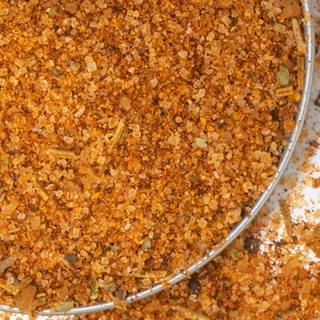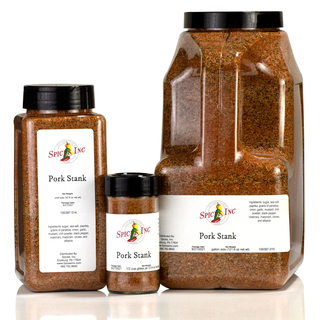Pork Stank




Pork Stank
Pork Stank has been one of our top-selling pork rubs since we added it to our lineup over a decade ago. It was created for us by the owner of a competition barbecue team who also ran a successful barbecue catering business.
This is a flavorful all-purpose pork rub and is more sweet than hot, like many great pork rubs. This 16-ingredient pork rub has won competitions up and down the east coast in both the pork butt and pork rib categories. We tested this in our test kitchen using pork shoulder. We tasted it without sauce to get the pork rub’s full flavor. Our kitchen taste testers claimed it was perfect.
Flavor Profile
Pork Stank is sweet and earthy with some herby undertones and a very mild back-of-the-throat heat.
How to Use
When using Pork Stank as a pork rub, you can apply it in advance, with some people liking to apply it 8-24 hours before smoking. The truth is that most of the rub's molecules are too large and will penetrate less than a 1/2" into the meat during this time.
A good pork rub is meant more as a surface treatment for flavor and to create the bark. We like to apply the rub just before cooking with a thin layer of oil (olive, canola, or vegetable oil all work well), as most of the flavors in the rub are oil soluble. Spread the rub generously on the thicker portions of the shoulder.
You want to maximize the flavor when smoking large cuts of pork butts because these roasts have a great deal of meat compared to the available surface area. You need to get the most out of your rub and apply as much of the Pork Stank into the meat as it will hold.
One trick we did learn from our time working with the competition barbecuers was to add two tablespoons of Pork Stank to one cup of apple juice to spray on the meat while it is smoking.
Once the pork butt hits 150 to 160°F, the moisture from inside the meat starts to move to the surface and begins evaporating, which cools the surface of the meat. This is what starts drying the exterior and helps form the bark.
If you're not familiar with a pork shoulder, there are two halves, the "Boston butt" (also called the pork butt) and the "picnic ham.” The "butt" comes from the top half of the shoulder, from the back of the pig near the spine through the shoulder blade.
Butts normally weigh between 4 and 14 pounds and typically have shoulder blade bones, although some butchers will remove the bones and sell them as "boneless butts.” Calling it, a butt seems odd since it comes from the front of the hog. But make no mistake, when seasoned and smoked correctly, this portion of the hog provides the tastiest meat for pulled pork sandwiches.
In addition to pork butts and pork ribs, this Pork Stank is equally delicious on ham and pork chops.
| Ingredients | Turbinado sugar, salt, paprika, demerara sugar, grains of paradise, onion, garlic, mustard, chili powder, black pepper, rosemary, marjoram, clove, and allspice. |
| Also Called | Pork rub, competition rubs, and rubs for pork |
| Recommended Uses | Pulled pork, pork ribs, pork chops, and ham |
| Flavor Profile | sweet and earthy with some herby undertones and very mild back-of-the-throat heat |
| Cuisine | American |
| How To Store | Airtight container in a cool, dark place |
| Shelf Life | 6-12 months |
| Country of Origin | USA |
| Dietary Preferences |
Nutrition Facts
Serving Size1 tsp
Amount Per Serving
Calories10
% Daily Value*
Total Fat0g0%
Saturated Fat0g0%
Trans Fat0g
Polyunsaturated Fat0g
Monounsaturated Fat0g
Cholesterol0mg0%
Sodium300mg13%
Total Carbohydrate2.3g1%
Dietary Fiber0.3g1%
Total Sugars1.6g
Added Sugars0g0%
Sugar Alcohol0.0g
Protein0.2g0%
Vitamin D0mcg0%
Calcium5mg0%
Iron0mg1%
Potassium19mg0%
*The % Daily Value (DV) tells you how much a nutrient in a serving of food contributes to a daily diet. 2,000 calories a day is used for general nutrition advice. These values were calculated and therefore are approximate. For more accuracy, testing is advised.
